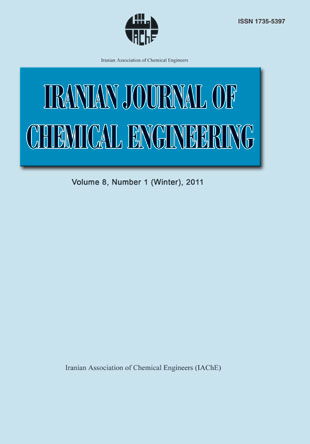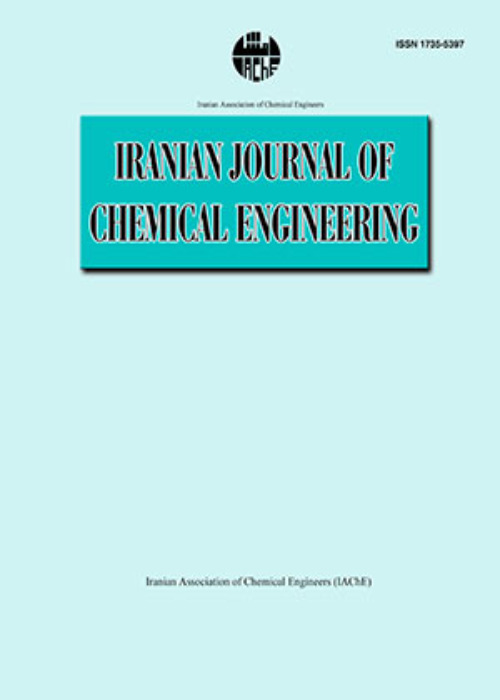فهرست مطالب

Iranian journal of chemical engineering
Volume:8 Issue: 1, Winter 2011
- تاریخ انتشار: 1390/01/22
- تعداد عناوین: 8
-
-
Page 3In gas condensate reservoirs, by reservoir depletion, pressure decreases below the dew point pressure of the fluid and condensate forms in the reservoir. This heavy part of the gas has found many applications in industry and also in daily life. When condensate drops out in the reservoir not only is this valuable liquid lost, but also its accumulation results in forming a condensate bank near the wellbore region. The created bank makes a considerable reduction in gas well productivity. These facts demonstrate that finding an economical way to increase the condensate recovery from condensate reservoirs is essential.In this study gas injection has been simulated in a gas condensate reservoir to increase the condensate recovery factor. In addition, capability of injection of different types of gas in condensate recovery has been compared through different injection schemes. The injection schemes that have been considered are: different injection rates, different reservoir pressures at which the injection is implemented and different injection durations. A compositional simulator was applied to simulate a simplified gas condensate reservoir model. The injection pattern was a one-eighth of a five-spot pattern with finer grids near the producer and injector. The simulation results showed an increase in condensate recovery from 5% to 30% in all injection cases. Many parameters can affect the decision of selecting the injection scheme, other than the gas and condensate recovery factor. Therefore, an economical evaluation and analysis is inevitable to take them all into account to determine the optimum scheme.
-
Page 15The shelf life of fish was extended using disinfection properties of ozone. For this purpose, Trout specimens were exposed to ozone in the aqueous media for two hours and their microbial growth and biochemical properties were measured over time. Microbial growth of ozone treated fish was significantly slower than the control sample, resulting in lower counts of bacteria (Acceptable point: less than 5*104/gr or cm2). According to the biochemical tests; ozone treatment had no negative effects on fat, protein and the humidity of the fish. Peroxide and TVN (Total Volatile Nitrogen) measurements showed that treatment by ozone increased the trout shelf life from 4 days to 6 days. According to the sensory analysis, no changes were observed in the color or flavor of the ozone treated trout.
-
Page 20Polymer adsorption by nanoparticles improves the stability of these types of suspensions against aggregation. In this work, the surface adsorption of polyethylene glycol (PEG) and polyvinyl alcohol (PVA) with different molecular weights onto the Zinc oxide (ZnO) nanoparticles is studied. The effects of solution pH value and temperature on the adsorption process are also investigated. The ZnO nanoparticles are then analyzed using Fourier transform infra red (FTIR), X-ray diffraction (XRD) and thermogravimetric analysis (TGA) techniques. The aggregation of nano particles before and after polymer adsorption is also investigated by scanning electron microscopy (SEM). The results show that by adsorbing the PEG and PVA, due to a relatively large electrostatic repulsive force between ZnO nano particles, the size of aggregated nanoparticles decreases. It has also been revealed that the low molecular weight polymers exhibit a higher adsorption rate on the particles’ surfaces in comparison to the polymers with high molecular weight.
-
Page 31Total combustion of methyl ethyl ketone and benzyl alcohol as two models of volatile organic compounds (VOCs) using catalytic method was studied over γ-Al2O3 and Mn/γ-Al2O3 catalysts. Catalyst (Mn/γ-Al2O3) was prepared by wet impregnation and characterized using XRD, BET, ICP-AES and SEM methods and the nanostructure of the catalyst were approved. The activity of the catalysts was measured in a catalytic packed bed reactor under atmospheric pressure and different reaction temperatures at range 150 to 450°C. The studies confirmed that manganese supported on γ-Al2O3 can be suitable for the abatement of the mentioned pollutants from contaminated air and hopefully holds the promise for the elimination of VOC containing hazardous materials in industrial applications.
-
Page 38In this investigation, in order to study the effect of hydrodynamic parameters such as impeller speed and hold-up, two series of experiments have been performed with a single stage horizontal mixer-settler equipped with 2 four-blade impellers. In the first series, 15 experiments were carried out with toluene/water system and in the second series, 60 experiments were carried out with toluene/acetone/water system. Results show that in both systems, when the hold-up is constant, the mean drop size decreases with increasing impeller speed and when the impeller speed is constant, the mean drop size increases with increasing hold-up, however, these manners for any system are different quantitatively. It shows that with the addition of solute (acetone) concentration in the system, the mean drop size decreases. The experimental results were compared with the Desnoyer and Quadros models, of which the Quadros model has a little deviation from Desnoyer model.
-
Prediction of Gas Hydrate Forming Pressures by Using PR Equation of State and Different Mixing RulesPage 46In this work, the ability of different mixing rules for the prediction of hydrate formation pressure are compared. For this purpose, by using Van der Waals–Plauteeuw model for solid hydrate phase and PR equation of state for calculation of fugasity of components in gas and liquid phases, the pressure of hydrate formation in different mixtures has been calculated by four different mixing rules: Van der Waals, Danesh, GNQ and Wong-Sandler, then by comparison of the calculated results with experimental data, the accuracy of the mixing rules were determined. Studied systems contain binary mixtures CH4, C2H6, C3H8, i-C4H10, CO2, and H2S with water in hydrate forming conditions. The interaction parameters in each mixture have been optimized by using two phase equilibrium data and then the optimized parameters have been used for three phase equilibrium calculations. Comparison of the calculated pressure of hydrate forming with experimental pressure shows that for most mixtures in the studied temperature and pressure ranges, the GNQ mixing rule with an average percent of error 6% has more accuracy than the three other mixing rules: Van der Waals, Danesh and WS. According to the obtained results for methane equilibrium concentrations in liquid phase, it seems that Danesh mixing rule is more efficient for the prediction the mole concentrations of components. Since Danesh rule considers the polarity of the water molecule, it has greater precision in predicting the equilibrium fractions.
-
Page 56Morphological and thermal properties of PA6/NBR nanocomposites prepared through a direct melt mixing process in an internal mixer were studied. The effects of the NBR content (10, 30, and 50%) and nanoclay loading (3, 5, and 7%) on the microstructure properties of nanocomposites have been reported and compared with PA6/NBR blends as well. The thermoplastic elastomer (TPE) nanocomposites were characterized by X-ray diffraction (XRD), transmission electron microscopy (TEM), scanning electron microscopy (SEM), volume swelling in oil, differential scanning calorimeter (DSC) and dynamic mechanical thermal analysis (DMTA). XRD results show that Cloisite 30B is exfoliated into the PA6 and NBR. TEM image of the PA6/NBR/nanoclay composite confirms partial exfoliated structure of silicate layers dispersed into the both NBR and PA6 phases. The SEM photomicrograph of PA6/NBR nanocomposite shows an increasing of the rubber particles size in comparison with unfilled PA6/NBR TPE. By the presence of nanoclay, improved oil resistances of the prepared TPE nanocomposites were achieved. DSC studies show that loading of the nanoclay reduces the degree of crystallinity of the nanocomposite samples. The DMTA test shows that storage modulus of the PA6/NBR nanocomposite increases in comparison with the PA6/NBR blend. It also explains a reduction in damping by loading of the nanoclay.
-
Notes for AuthorsPage 66


